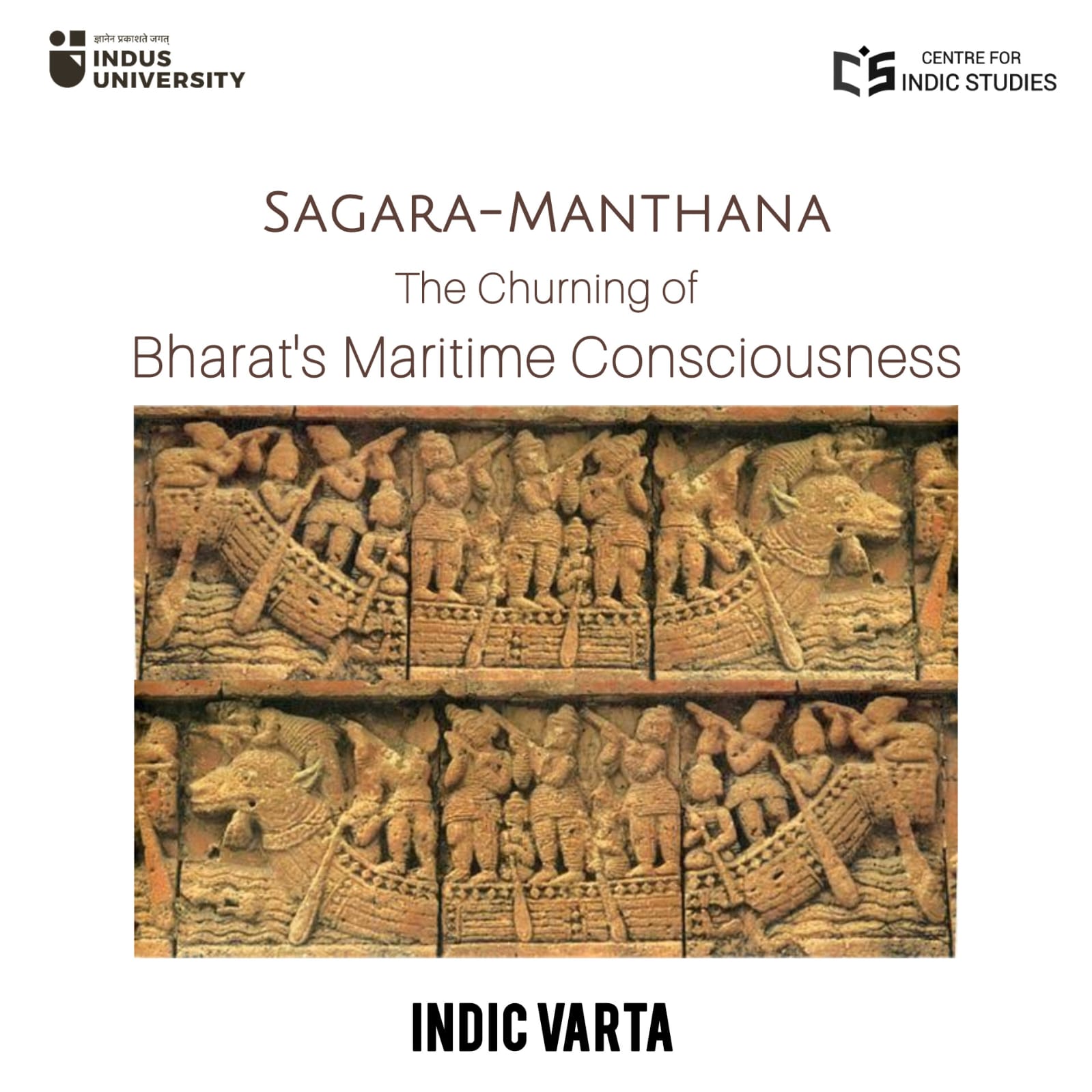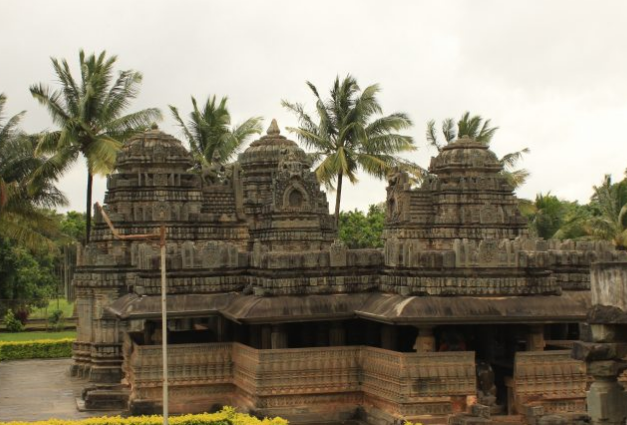- Visitor:67
- Published on: 2025-04-05
Sagara-Manthana: The Churning of Bharat’s Maritime Consciousness
This shift from an Indic maritime order, characterized by fluid, culturally integrated trade, to a European model of conquest and exploitation represents a profound loss. The Indian Ocean, which was once the lifeline of cultural exchange and economic prosperity, was redefined as a domain for military dominance and resource extraction by external powers. This period of colonial sabotage not only stunted the growth of our maritime industries but also instilled a long-lasting narrative that India was, and perhaps still is, a land-bound civilization.

In the early 19th century, Francis Scott Key, aboard HMS Minden, a ship built in Bharat, penned “The Star-Spangled Banner.” A powerful irony: an American anthem born on an Indian-made vessel, a relic of our lost maritime glory. Yet today, Bharat’s maritime legacy remains buried under colonial amnesia, acknowledged only in naval circles while the public remains unaware.
This demands a Sagara-Manthana, a churning of our oceanic past, not for mythical nectar but for reclaiming our seafaring identity. Bharat’s name adorns an ocean, a testament to its historic maritime dominance. From the dockyards of Lothal to the naval conquests of the Cholas and Shivaji’s coastal strategies, the seas were once our theatre of ambition. Yet, colonial rule dismantled our shipbuilding, reduced us to a landlocked mindset, and erased our maritime consciousness.
Post-independence, have we truly reclaimed this legacy? While China encircles us with its String of Pearls, and the West dominates maritime discourse, Bharat still hesitates to see the ocean as its strategic axis. This is not about nostalgia but about reclaiming the seas as the key to our resurgence. The Sagara-Manthana has begun, will Bharat seize its maritime destiny, or will it once again drift with the tide?
The ocean occupies a central place in ancient Indic texts. The Ramayana recounts the journey of Sugriva and his Vanaras as they traverse the seas toward distant lands like Yavadvipa (modern Java) and Suvarnabhumi (Burma and Thailand). These passages are not mere myth; they point to the existence of well-established maritime trade routes and the confidence with which our forefathers sailed beyond known horizons. Similarly, the Mahabharata, especially in its Sabha Parva, describes the grandeur of Pandya and Chola kings who received precious gifts from overseas territories. The churning of the ocean, known as Samudra Manthan, transcends its mythological context. It symbolizes the Indic understanding of the sea as a reservoir of untapped power, a source of wealth, knowledge, and cultural exchange that far exceeded the confines of territorial boundaries.
Bharat’s maritime genius is equally evident in its engineering feats. The dockyard at Lothal, discovered in present-day Gujarat, is the world’s oldest known tidal dockyard. Constructed around 2400 BCE, it featured an ingenious water management system that harnessed tidal movements for the loading and unloading of goods. This early mastery of port design is a testament to the advanced engineering capabilities of the Indus Valley Civilization, long before similar developments were witnessed in Egypt or Mesopotamia.
This expertise in shipbuilding was not lost to time but was recorded and refined in classical texts. The Arthashastra by Chanakya (4th century BCE) lays out detailed policies on maritime trade, port taxation, and ship construction, even prescribing the appointment of a Navadhyaksha—a superintendent responsible for overseeing naval operations and shipbuilding. Later, treatises such as the Yuktikalpataru (11th century CE) further codified the science of naval architecture, describing various types of ships, their dimensions, and optimal designs for different sea conditions. Such works not only serve as technical manuals but also encapsulate a deep philosophical connection to the sea, where every vessel was conceived as a moving embodiment of cosmic order.
Even during colonial times, India’s shipbuilding prowess was renowned. The Wadia family of Bombay, a Parsi dynasty, upheld this ancient tradition with exceptional skill. Their shipyards produced some of the finest vessels commissioned by the British. Among these was HMS Minden (launched in 1810), as mentioned in the beginning. Another remarkable example is HMS Trincomalee (built in 1817), the world’s oldest warship still afloat, a living relic of an era when Indian shipbuilders were the gold standard in naval architecture.
However, this legacy was not immune to external forces. Colonial policies, such as the Navigation Acts (1651–1850) and the Charter Act of 1813, were deliberately designed to stifle indigenous maritime industries. By banning Indian-built ships from major trade routes and coercing local shipbuilders to serve the British maritime empire, these policies led to a catastrophic decline. By 1900, India’s once-dominant share in global shipbuilding had plummeted from a staggering 40% to virtually negligible levels. This systematic dismantling of our maritime prowess was not merely an economic strategy—it was a cultural amnesia imposed on a civilization that had once ruled the seas.
At its zenith, India’s maritime network was unrivalled. By 1 CE, it is estimated that India controlled over 60% of global maritime trade. Indian merchants exported textiles, spices, Wootz steel, and precious gems that were so coveted that they drained gold from the coffers of even the mighty Roman Empire, as noted by Pliny the Elder in his Natural History. Archaeological finds, such as Roman coins and amphorae discovered in Tamil Nadu, further attest to the fact that Indian trade networks extended as far as the Mediterranean, bypassing the need for Arab intermediaries.
During the reign of the Satavahanas (1st century BCE–3rd century CE), India’s maritime influence expanded even further. Their coins have been found in distant lands like the Arabian Peninsula and the Roman Empire, highlighting the extensive reach of Indic commerce. Trade was not solely about the exchange of goods; it was a vehicle for the transmission of art, culture, and technology. The subtle influences of Indic culture—ranging from architectural styles to religious practices—are still evident in regions such as Indonesia, Cambodia, and even parts of Africa, where ancient Hindu-Buddhist motifs have left an indelible mark.
No discussion of India’s maritime supremacy would be complete without a deep dive into the achievements of the Chola dynasty (9th–13th century CE). Under the visionary leadership of kings like Rajaraja I and Rajendra Chola I, the Chola navy emerged as the first true state-sponsored blue-water force in the world. Unlike European colonizers, whose ventures were marked by conquest and exploitation, the Cholas embarked on naval expeditions with the aim of securing trade routes and extending cultural influence and Indian soft power.
In 1025 CE, Rajendra Chola I launched a bold naval campaign against the Srivijaya Empire in modern-day Indonesia. This strategic offensive, which led to the capture of fourteen key ports, not only secured the Strait of Malacca but also ensured that Indian trade flowed seamlessly to China and the far reaches of the East. The impact of these conquests is evident in the cultural imprints left behind: majestic temples in Cambodia, such as Angkor Wat, and the architectural grandeur of Borobudur in Indonesia bear testimony to the widespread diffusion of Indic culture. The Chola expeditions were a masterclass in balancing military might with cultural diplomacy, a dual approach that defined the Indic method of maritime expansion.
Centuries after the Chola dominance, the Maratha ruler Shivaji epitomized indigenous maritime strategy in the face of European aggression. At a time when the Mughal Empire largely ignored the importance of naval power, Shivaji recognized that control of the seas was critical for maintaining sovereignty. The political landscape of the 17th century was rapidly changing; with the Portuguese gifting Bombay to the British in 1661, a new era of European dominance on the seas was dawning.
In response, Shivaji initiated the construction of a formidable naval force. He built twenty strategically located coastal forts along the Konkan coast, creating an impenetrable network that would serve as both defence and a platform for offensive operations. His naval commander, Kanhoji Angre (circa 1698–1729), became a legend in his own right. Angre repeatedly outmanoeuvred British, Portuguese, and Dutch fleets, inflicting losses that forced his adversaries into uneasy truces. Historical accounts note that in 1712, a joint attack by the British and Portuguese on Angre’s stronghold ended in failure, a testament to the efficacy of indigenous naval strategy. Shivaji’s legacy, therefore, is not only a tale of terrestrial valour but also a clarion call that control of the seas is indispensable for a nation’s sovereignty.
As centuries passed, the maritime prowess of Bharat was gradually eclipsed by the rise of European naval power. The transformation was neither accidental nor inevitable, it was the result of deliberate colonial policies designed to suppress indigenous industries. By the 18th century, Indian shipyards in cities like Surat, Bombay, and Calicut were responsible for building over 40% of the world’s ships. Yet, the British systematically dismantled this robust industry. The Navigation Acts and subsequent policies ensured that Indian merchants were forced to trade exclusively through British-controlled channels. Moreover, by the early 19th century, the once-thriving shipbuilding industry in India was reduced to a mere shadow of its former glory, its decline emblematic of a broader economic and cultural rupture.
This shift from an Indic maritime order, characterized by fluid, culturally integrated trade, to a European model of conquest and exploitation represents a profound loss. The Indian Ocean, which was once the lifeline of cultural exchange and economic prosperity, was redefined as a domain for military dominance and resource extraction by external powers. This period of colonial sabotage not only stunted the growth of our maritime industries but also instilled a long-lasting narrative that India was, and perhaps still is, a land-bound civilization.
Yet, history is not static. The maritime spirit of Bharat has proven resilient, and today we witness a resurgence in Indian naval power that is both strategic and symbolic. The modern era has seen significant strides in naval self-sufficiency and innovation. Projects such as INS Vikrant, commissioned in 2022, exemplify India’s determination to reclaim its blue-water capabilities. Similarly, INS Arihant, our first nuclear-powered submarine, and Project 75, which aims to build a modern fleet of submarines, underscore a renewed commitment to indigenous naval strength.
Beyond hardware, India is also carving out a crucial role on the global stage. In international maritime law and disputes, India is an active participant in UNCLOS (tUnited Nations Convention on the Law of the Sea), leveraging this platform to assert its rights and shape the rules governing the world’s oceans. In strategic forums and regional alliances, such as the Indian Ocean Rim Association and the SAGAR initiative (Security and Growth for All in the Region), India champions a philosophy of soft power, one that favours diplomatic engagement and economic cooperation over military confrontation. This nuanced approach is a modern echo of the ancient Indic perspective, where the ocean was not a domain to be conquered by force but a conduit for cultural and economic exchange.
An Indic perspective of maritime
At its core, the Indic approach to maritime power is fundamentally different from the Western narrative. While Western history is replete with tales of colonization, exploitation, and the use of naval might to enforce dominance, Bharat’s maritime tradition has always been rooted in dharmic principles. Trade routes were not tools for plunder; they were bridges connecting diverse cultures, fostering mutual respect and shared prosperity. The spread of Indian art, religion, and science across Southeast Asia is a clear manifestation of this philosophy, a form of soft power that has left an indelible cultural legacy without the need for coercion.
Even today, as Western powers project hard power through military bases and strategic alliances, India’s approach is one of balance and integration. Initiatives like SAGAR highlight a commitment to regional security through collaboration, ensuring that the oceans serve as arenas of cooperation rather than confrontation. In essence, the modern Indian maritime policy is an attempt to revive an age-old Indic wisdom, a wisdom that recognizes the ocean as a space for peaceful coexistence, economic integration, and cultural dialogue.
Historically, the maritime industry was the economic backbone of Bharat. Ancient Mauryan and Gupta records extolled shipbuilding as a state-supported enterprise, and the Arthashastra laid out comprehensive guidelines for maritime governance. During its zenith, India’s shipyards not only fuelled a vast trade network but also underpinned local economies. The evidence is compelling: in the 18th century, Indian shipyards were responsible for building nearly 40% of the world’s ships, a testament to the unmatched skill and scale of our maritime industry.
The catastrophic decline of this sector under colonial rule is a poignant reminder of what was lost. Today, India ranks among the top 10 ship-producing nations globally, yet it still lags the likes of China and South Korea in terms of overall market share and technological innovation. Recognizing this gap, the modern Indian government has launched ambitious initiatives such as the Sagarmala project, aimed at modernizing ports, enhancing logistics, and reviving the Blue Economy. This strategic focus is not merely about boosting GDP, it is about restoring a sense of national pride and reclaiming our rightful place in global maritime affairs. With the Blue Economy now contributing nearly 4% to India’s GDP, the economic imperative for a maritime renaissance has never been more urgent.
Towards a Maritime Renaissance
Bharat has never been a civilization confined by rigid borders, it has always been fluid, expanding not through conquest alone but through the seamless flow of trade, philosophy, and cultural exchange. The pulse of our civilization was never just in its landlocked empires but in the unbroken dialogue between coast and continent, between the rivers that nurtured our heartlands and the oceans that carried our ideas to distant shores. But without its maritime strength, Bharat risks becoming a land-bound entity, cut off from the very dynamism that once made it a global force. A civilization that once dictated the rhythm of the waves now hesitates at the shore, unsure whether to reclaim its seafaring legacy or remain shackled to a continental mindset imposed by colonial amnesia.
The “Sagara-Manthana” is upon us. The churning of the ocean, both mythical and strategic, demands more than nostalgia; it calls for vision, for audacity, for the will to break free from the inertia of the past. Will we once again embrace the ocean as our bridge to power, prosperity, and cultural resurgence? Or will we let the tides of history wash away what remains of our maritime inheritance? The ocean does not ask for hesitation, it beckons us to return, not as mere observers, but as masters of our own destiny. The choice is ours.
Bibliography
Arthashastra by Chanakya, 4th century BCE
Periplus of the Erythraean Sea, 1st century CE
Pliny the Elder, Natural History, 1st century CE
Archaeological Survey of India reports on the Lothal dockyard
K.A. Nilakanta Sastri, The Cholas
Accounts of Kanhoji Angre and Shivaji’s naval campaigns
Historical data on Indian shipbuilding (1700–1900) from British Parliamentary Records and trade reports
Modern naval commissioning records for INS Vikrant (2022), INS Arihant, and Project 75
Reports on the Sagarmala project and Blue Economy contributions
- 33 min read
- 5
- 0










